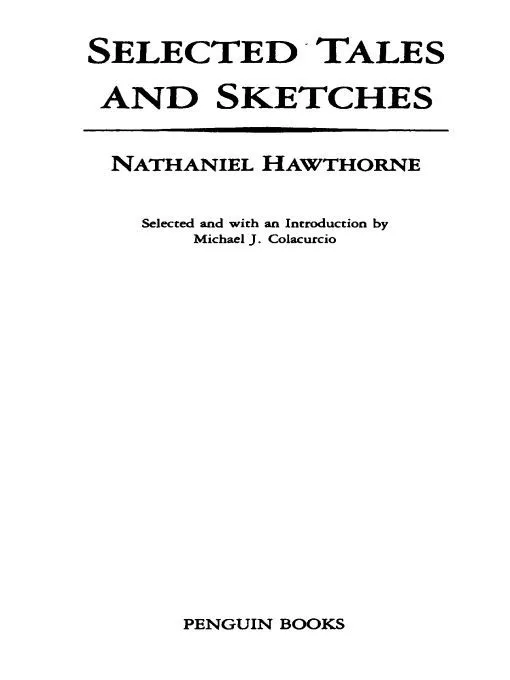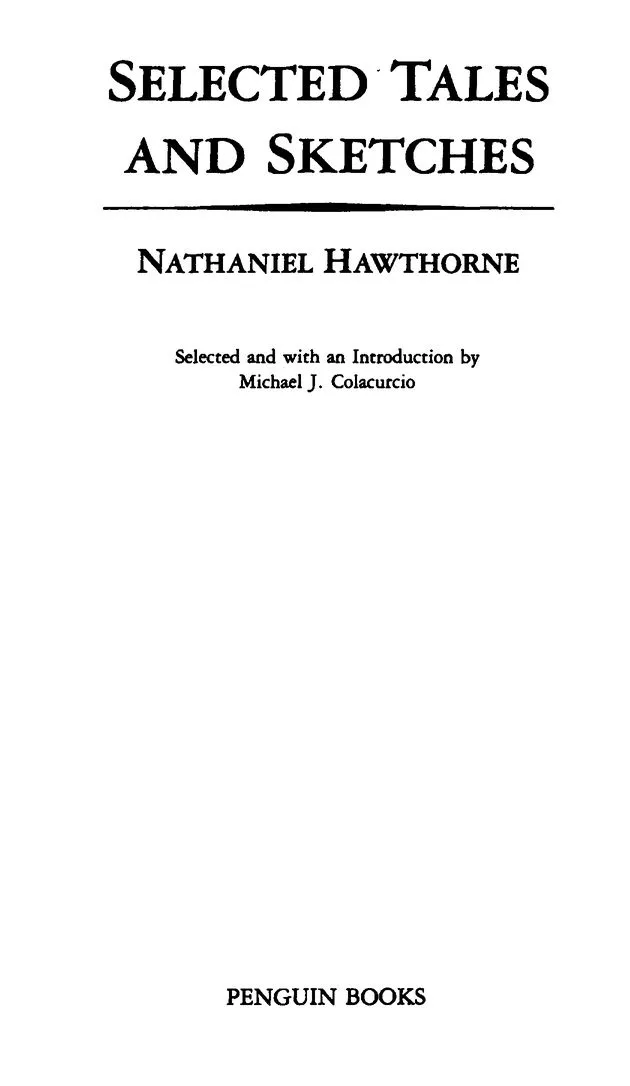Selected Tales and Sketches

Table of Contents
Title Page
Copyright Page
Introduction
The Hollow of the Three Hills
Sir William Phips
Mrs. Hutchinson
The Wives of the Dead
My Kinsman, Major Molineux
Roger Malvin’s Burial
Passages from a Relinquished Work
Mr. Higginbotham’s Catastrophe
The Haunted Mind
Alice Doane’s Appeal
The Gray Champion
Young Goodman Brown
Wakefield
The Notch of the White Mountains
The Ambitious Guest
The May-Pole of Merry Mount
The Minister’s Black Veil - A PARABLE
Sunday at Home
The Man of Adamant - AN APOLOGUE
Endicott and the Red Cross
Night Sketches
Edward Randolph’s Portrait - FROM LEGENDS OF THE PROVINCE-HOUSE
The Hall of Fantasy
The Birth-mark
Egotism; or, The Bosom-Serpent - FROM THE UNPUBLISHED “ALLEGORIES OF THE HEART”
The Christmas Banquet - FROM THE UNPUBLISHED “ALLEGORIES OF THE HEART”
The Celestial Rail-road
Earth’s Holocaust
The Artist of the Beautiful
Rappaccini’s Daughter - FROM THE WRITINGS OF AUBÉPINE
Ethan Brand - A CHAPTER FROM AN ABORTIVE ROMANCE
Suggestions for Further Reading

HAWTHORNE: SELECTED TALES AND SKETCHES
Nathaniel Hawthorne (1804-1864) was born in Salem, Massachusetts, where, after his graduation from Bowdoin College in Maine, he wrote the bulk of his masterful tales of American colonial history, many of which were collected in his Twice-told Tales (1837). In 1839 and 1840 Hawthorne worked in the Boston Customs House, then spent most of 1841 at the experimental community of Brook Farm. After his marriage to Sophia Peabody, he settled in the “Old Manse” in Concord; there, between 1842 and 1845, he wrote most of the other tales in this volume, first gathered in a collection entitled Mosses from an Old Manse (1846). His career as a novelist began with The Scarlet Letter (1850), whose famous preface recalls his 1846-1849 service in “The Custom-House” of Salem. The House of the Seven Gables (1851) and The Blithedale Romance (1852) followed in rapid succession. After a third political appointment—this time as American Consul in Liverpool, England, from 1853 to 1857—Hawthorne’s life was marked by the publication of The Marble Faun (1860) but also by a sad inability to complete several more long romances. Ill health, apparently, and possibly some failure of literary faith finally eroded Hawthorne’s striking ability to make imaginative sense of America’s distinctive moral experience.
Michael J. Colacurcio is the author of The Province of Piety: Moral History in Hawthorne’s Early Tales and of various essays and reviews in the field of American literature. He has also edited and contributed to a volume of New Essays on The Scarlet Letter. He is currently Professor of English and American Studies at UCLA.

BookishMall.com
Published by the Penguin Group
Penguin Group (USA) Inc., 375 Hudson Street, New York, New York 10014, U.S.A.
Penguin Group (Canada), 90 Eglinton Avenue East, Suite 700, Toronto, Ontario,
Canada M4P 2Y3 (a division of Pearson Penguin Canada Inc.)
Penguin Books Ltd, 80 Strand, London WC2R ORL, England
Penguin Ireland, 25 St Stephen’s Green, Dublin 2, Ireland (a division of Penguin Books Ltd)
Penguin Group (Australia), 250 Camberwell Road, Camberwell, Victoria 3124, Australia
(a division of Pearson Australia Group Pry Ltd)
Penguin Books India Pvt Ltd, 11 Community Centre, Panchsheel Park,
New Delhi - 110 017, India
Penguin Group (NZ), 67 Apollo Drive, Rosedale, North Shore 0632, New Zealand
(a division of Pearson New Zealand Ltd)
Penguin Books (South Africa) (Pty) Ltd, 24 Sturdee Avenue, Rosebank,
Johannesburg 2196, South Africa
Penguin Books Ltd, Registered Offices: 80 Strand, London WC2R ORL, England
First published in the United States of America by Penguin Books 1987
Published simultaneously in Canada
Introduction and compilation copyright © Viking Penguin Inc., 1987
All rights reserved
The text of the stories in this collection is that established by the Centenary
Edition of the Works of Nathaniel Hawthorne published by the Ohio State University
Center for Textual Studies and Ohio State University Press. The selections are
from the volumes entitled Twice-Told Tales, Mosses from an Old Manse, The Snow-Image
and Uncollected Tales, and Miscellany. Copyright © Ohio State University
Press, 1974, 1987. All rights reserved.
Acknowledgment is made to The Library of America for their assistance in the
production of this book.
LIBRARY OF CONGRESS CATALOGING-IN-PUBLICATION DATA
Hawthorne, Nathaniel, 1804-1864.
Selected tales and sketches.
(Penguin classics)
Bibliography: p.
I. Colacurcio, Michael J. II. Title.
PS1852.C’.3 86-21247
eISBN : 978-1-101-07780-1
3
The scanning, uploading and distribution of this book via the Internet or via any
other means without the permission of the publisher is illegal and punishable by law.
Please purchase only authorized electronic editions, and do not participate in or encourage
electronic piracy of copyrighted materials. Your support of the author’s rights is appreciated.
http://us.penguingroup.com
Introduction
When Hawthorne recollected, in the often quoted Preface to the third edition of his Twice-told Tales (1851), that he had once found himself “the obscurest man of letters in America,” he was speaking of a phase of his career that had long since lapsed. The Scarlet Letter (1850) had not yet had time to establish itself as the classic we now universally recognize—that miracle of meditation which transcends provincial origin and subject matter to become a standard of World Literature; but it was already a significant critical and popular success. The House of the Seven Gables ( 1851), which Hawthorne himself in some moods preferred to The Scarlet Letter, would further secure his reputation. And by the time The Blithedale Romance (1852) was making its way among reviewers and booksellers, a somewhat envious Herman Melville could write his recently estranged friend that “this name of ‘Hawthorne’ seems to be ubiquitous.”
But if these three extended fictions—the “American Romances,” as Henry James would name them in his critical biography of 1879—established Hawthorne in that rich and catholic world we treasure as “fiction in English,” and also at the center of an ongoing critical debate we recognize as “novel versus romance,” it remains true that those shorter fictions Hawthorne produced in the decades prior to 1850 amount to far more than a long foreground to worldly success. Indeed the total achievement of his earlier tales and sketches is so remarkable that Hawthorne would merit a place in the first rank of American authors even if he had written none of his longer works. Nor would the literature of any modern nation-state be anything but significantly enhanced if Nathaniel Hawthorne had happened to be born there and to have subjected its peculiar moral history to his unique style of fictional analysis.
Yet Hawthorne remains emphatically an American writer—self-consciously then and distinctively now. Most obviously: as no one escapes the pressures of history, so this notable descendant of the American Puritans could scarcely have eluded all trace of their conscientious and symbolic manner of taking the world. More significantly, his American-ness reveals itself in terms he consciously learned, by immersing himself, at the outset of his career, in the whole sequence of colonial and provincial texts which inevitably express the Puritan Mind and arguably control American Identity.
That is to say, Hawthorne did not merely inherit his status or assume his function as an “American” author; rather, he studied to recreate and meditated to judge the special quality of moral experience in his native land.
1 comment